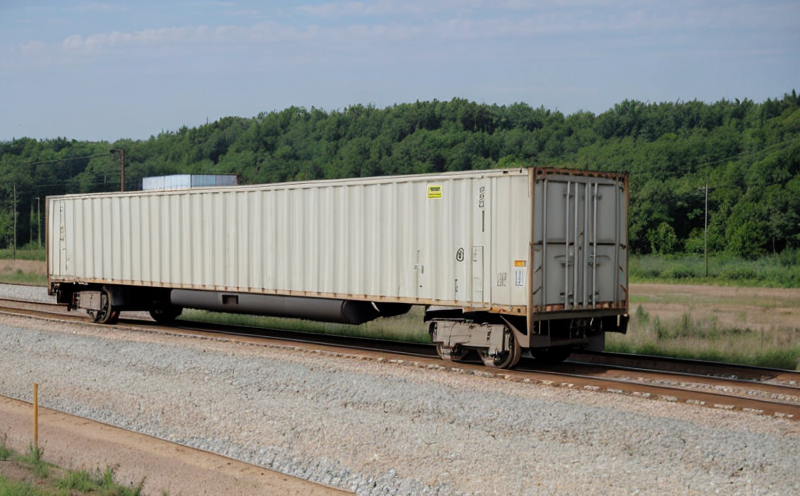EN 12663 Roof Load Testing of Freight Wagons
The European standard EN 12663 specifies the procedure for determining the maximum load capacity of roofs on freight wagons. This testing is crucial for ensuring that freight wagons are capable of safely carrying heavy loads without structural failure or compromise to passenger safety in mixed-traffic environments.
Freight wagons must be able to withstand significant roof loads, especially when transporting cargo like machinery, construction materials, or other heavy items. The test outlined in EN 12663 ensures that the design and manufacturing process of these wagons meet stringent safety requirements set by European railway authorities. This testing is mandatory for all new freight wagons entering service within the EU.
The roof load tests are conducted under controlled conditions to simulate real-world scenarios where the wagon might encounter heavy loads or extreme weather conditions. The testing apparatus, which includes a loading frame and a hydraulic system capable of applying progressively increasing loads, ensures precise measurement of the structural integrity of the roof.
Once the test is complete, the data collected provides critical insights into the performance and durability of the freight wagon's roof. This information is essential for manufacturers to optimize their designs and ensure compliance with all relevant safety regulations. The results also help quality managers and compliance officers make informed decisions regarding procurement and maintenance schedules.
The methodology involves carefully preparing the specimen by ensuring it is in its original, undamaged condition before loading begins. The loading process follows a predefined schedule where incremental weights are applied until either the specified maximum load or structural failure occurs. Throughout this process, detailed records of all measurements and observations are kept to ensure accurate documentation.
The acceptance criteria for passing this test are based on the structural integrity remaining intact up to the specified roof load limit without any visible signs of damage. This ensures that the freight wagon can safely carry its intended cargo under normal operating conditions. Compliance with EN 12663 is not only a legal requirement but also a testament to the manufacturer's commitment to safety and quality.
By adhering to this standard, manufacturers and railway operators demonstrate their adherence to international best practices, enhancing trust and reliability in the transportation sector. The test results contribute to the overall safety of rail transport systems by ensuring that each wagon is capable of handling its intended load safely and efficiently.
Scope and Methodology
The scope of EN 12663 covers the determination of the maximum permissible roof load capacity for freight wagons. The methodology involves several key steps to ensure accurate testing:
- Preparation of the specimen, ensuring it is in its original, undamaged condition.
- Setting up the loading frame and hydraulic system capable of applying progressively increasing loads.
- Applying incremental weights until either the specified maximum load or structural failure occurs.
- Recording all measurements and observations during the testing process.
The acceptance criteria for passing this test are based on maintaining structural integrity up to the specified roof load limit. Any visible signs of damage would result in a failed test, indicating that the freight wagon does not meet the required safety standards.
By adhering to these steps and meeting the acceptance criteria, manufacturers can ensure their products comply with European railway regulations, thereby enhancing safety and reliability in rail transport systems.
Why Choose This Test
- Ensures compliance with EN 12663 international standards.
- Mandatory for all new freight wagons entering EU service.
- Guarantees the structural integrity of the roof under heavy loads and extreme weather conditions.
- Provides critical data for optimizing design and manufacturing processes.
- Enhances trust and reliability in rail transport systems.
Selecting EN 12663 Roof Load Testing is essential for manufacturers aiming to meet stringent safety requirements set by European railway authorities. It ensures that freight wagons can safely carry heavy loads, thereby enhancing the overall performance and reliability of rail transport systems. This test not only meets legal obligations but also contributes to improving public trust in the transportation sector.
Use Cases and Application Examples
- Testing new freight wagons before entering EU service.
- Evaluating existing freight wagons for compliance with safety regulations.
- Ensuring that modifications to the roof structure do not compromise safety.
- Verifying the performance of roof reinforcements during design and development phases.
In real-world applications, this test is used by quality managers, compliance officers, and R&D engineers. It ensures that manufacturers can produce safe and reliable freight wagons that meet all necessary regulatory requirements. For procurement teams, these tests provide valuable data for selecting the right suppliers and ensuring consistent product quality.





